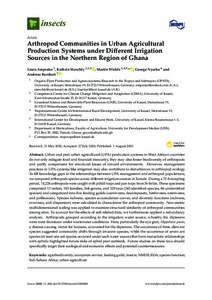| dcterms.abstract | Urban and peri-urban agricultural (UPA) production systems in West African countries do not only mitigate food and financial insecurity, they may also foster biodiversity of arthropods and partly compensate for structural losses of natural environments. However, management practices in UPA systems like irrigation may also contribute to disturbances in arthropod ecology. To fill knowledge gaps in the relationships between UPA management and arthropod populations, we compared arthropods species across different irrigation sources in Tamale. During a 72-h sampling period, 14,226 arthropods were caught with pitfall traps and pan traps from 36 fields. These specimens comprised 13 orders, 103 families, 264 genera, and 329 taxa (243 identified species, 86 unidentified species) and categorized into five feeding guilds (carnivores, decomposers, herbivores, omnivores, and pollinators). Species richness, species accumulation curves, and diversity functions (richness, evenness, and dispersion) were calculated to characterize the arthropod community. Non-metric multidimensional scaling was applied to examine structural similarity of arthropod communities among sites. To account for the effects of soil-related data, we furthermore applied a redundancy analysis. Arthropods grouped according to the irrigation water source, whereby the dipterans were most dominant under wastewater conditions. Here, particularly the eye gnat, Hippelates pusio, a disease-causing vector for humans, accounted for the dipterans. The occurrence of three alien ant species suggested community shifts through invasive species, while the occurrence of seven ant species (at least one ant species occurred under each water source) that form mutualistic relationships with aphids highlighted future risks of aphid pest outbreak. Future studies on these taxa should specifically target their ecological and economic effects and potential countermeasures. | eng |


